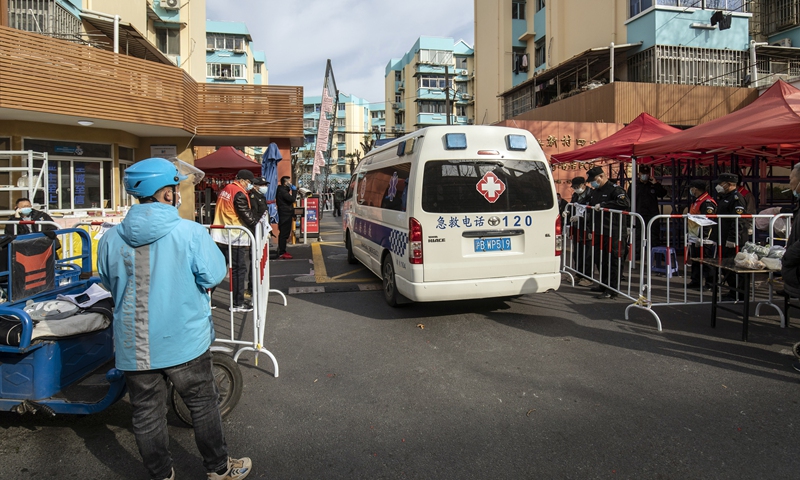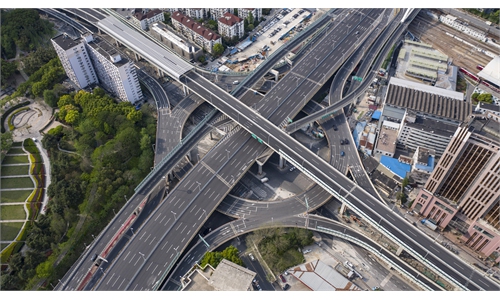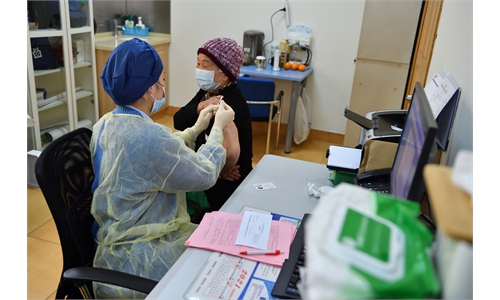Update: Over 20 regions under static management to fight Omicron flare-ups, affecting about 50 million people

An ambulance enters a residential neighborhood placed under lockdown due to Covid-19 in Shanghai on March 10, 2022. Photo: VCG
Over 20 cities or regions across China - collectively home to about 50 million residents - are currently under static management to fight sweeping Omicron flare-ups. Chinese health experts said static management policy is necessary for the country to win the fight against the fast-transmitting Omicron within the dynamic zero-COVID strategy.
Among the latest examples, Guye District of Tangshan in North China's Hebei Province has imposed static management starting from Monday. Local residents are prohibited from leaving their homes.
Wuhu city in east China's Anhui Province also imposed static management on its urban areas since Sunday after discovering a local positive COVID-19 case. Mass nucleic acid testing was rolled out immediately and all public transport suspended. Yingshang County in Anhui Province will also impose static management starting from Monday afternoon.
Suining County in East China's Jiangsu Province shut down its train station to escalate epidemic control management as 89 positive COVID-19 cases were reported on Sunday. All residents were asked to stay at home and receive nucleic acid tests.
The static management is usually followed by mass nucleic acid testing and public transport suspension. Social gatherings will be cancelled except those to ensure the livelihood of citizens and the basic operation of the city, according to media reports.
To cope with a potential attack of the Omicron variant, Anhui Province's Hefei even held a drill to practice how the city would act under the static management on Sunday, in a bid to strengthen their emergent dealing capabilities.
But so many cities entering static management have caused some netizens to doubt over its necessity and whether some local governments are overacting by launching such management after just discovering a few cases. Some places did so even before a positive case was found out of precaution for potential outbreaks, while worries arose whether the local economy would be affected in case of an outbreak.
Experts tried to ease such concerns by stressing that static management policy is necessary for the country to win over the fast-transmitting Omicron within the dynamic zero-COVID strategy.
Given the fast transmission rate of Omicron, one case can lead to infection of about 10 others in a very short period of time. In the view of this, static management is a necessary method to achieve dynamic zero when individual cases or epidemics occur. "Lessons from Shanghai and Northeast China's Jilin Province show us that we must act fast enough to cut off Omicron spread before its transmission reaches our limitation to control it," a senior expert from the Chinese Center for Disease Control and Prevention told the Global Times on Monday on condition of anonymity.
Besides, unlike city lockdowns that cause massive standstills of work and life, these measures are specified and targeted according to the local situation, trying to minimize the impact on people's daily activities, experts noted.
For example, in the areas in Suzhou that are under static management, those who have to go to work are allowed to leave their homes and enter their company premises with COVID-19 test results taken within 24 hours, valid passes and health codes.
According to the control measures Suzhou released on Saturday, residents can still take taxis, subways and buses after temperature checks and 24-hour COVID-19 test results. People can leave the city with nucleic acid test results taken within 24 hours if they really need to.
As to places that have launched static management before a positive case is found, experts said their precautious and protective measures are needed as these places are located next to other places that are having outbreaks. For example, Nanhe District in Xingtai County in Hebei has not reported any local case but has been put under static management since early April as its neighbor, Jize County, is combating an outbreak.



